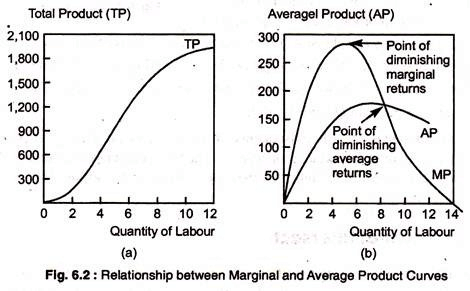Marginal and Average Product Curves (With Diagram) - Commerce PDF Download
Ref: https://edurev.in/question/651418/When-plotting-mp-and-ap-curves-does-MP-crosses-MP-at-maximum-points-Related-MCQ-of-Ch-3-1-Theory-of
The upcoming discussion will update you about the relationship between marginal and average product curves.
In Fig. 6.2(b) we can see that the MP curve cuts the AP curve at the latter’s maximum point.
It is important to know why. The key is that the AP curve slopes upward as long as the MP curve is above it; it makes no difference whether the MP curve is itself sloping upwards or downwards.
Common sense tells us that, if an additional worker is to raise the AP of all workers, the worker’s output must be greater than the average output of all existing workers. It is immaterial whether his contribution to output is greater or less than the contribution of the workers hired immediately before him.
Since AP slopes upwards or downwards, MP first increases, then decreases and eventually becomes negative. The law of diminishing returns is also called the Law of Variable Proportions because it predicts the consequences of varying the proportion in which factor inputs are used.

Since AP slopes upwards or downwards, depending on whether MP is above or below AP, it follows that MP must equal AP at the highest point on the AP curve; when AP is falling, MP is below AP, pulling it down.
Long-run Change in Production:
In the long-run, all factors are variable. Firms wishing to maximise their profits will attempt to produce their chosen output by employing combinations of capital, labour and land which minimise their production costs. This cost-minimising effort can be shown graphically with the use of isoquants and isocost lines. These enable us to trace out the path along which a firm can expand in the long-run.

|
Explore Courses for Commerce exam
|

|

















